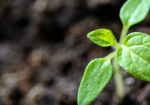Ron the Agronomist: “Restoring Soil to an Idyllic Past?”
July 10, 2021
How Ron the Agronomist is Leading Soil Restoration for a Healthier Agriculture Future
People always ask me why I put on my resumé that I grew up on a working dairy farm. It’s simple. In those days (1950’s), dairy farms were truly integrated systems.
We produced crops for the animals, skimmed the milk, and took the butter to the creamery. We took the skim milk and fed it to the pigs. We had extended crop rotations and livestock waste was spread on fields. Then, we lost our way. We got into this mania of producing corn and soybeans, which is more or less the same crop.
From a historical perspective, I was participating in agriculture back before the separation, if you will. I know some get dreamy and pastoral and think about going back to the good old days. Well, I was there, and those days were rough, and life was anything but simple. Money was short and we had crop failures.
I like to think that I do have a vision of where agriculture is going. And it’s informed by that past. We’re moving forward into an integrated system, leveraging the maximum natural forces that are bestowed upon us. By that I mean the sun, the wind, the rain and all other natural forces that can be leveraged for effective agriculture.
And part of our disappointment today is that we’ve been separated from those things.
In terms of the next iteration of agriculture, I talk a lot about restoration ag as opposed to sustainable ag.
People have a hard time defining or understanding sustainability. But when you talk about restoration, people have a faint idea of what that looks like. And in very simplistic terms, it means that every year our soil and our farm is better than it was the year before.
It’s not important how fast we’re moving in that direction. What is important is that our compass is heading in the direction of restoring agriculture.
Soil is that thin layer that separates heaven from Earth. And that soil, which I like to think of as only about a foot thick, provides all life on Earth. What we walk on––we disregard and called dirt––is what provides all life.
Interestingly, the microbes in the soil are the same microbes that are on our body.
The human body has a microbiome; an adult has around 8.5 pounds of microbes in and on the body, believe it or not.
These are the same microbes that we find in soil. So, when we start sterilizing our food, when we start eating from sterile soil, we are no longer sharing the microbes that had coevolved between soil, plants, and humans.
Any way you look at it, we must refocus on soil health. And there is a growing appetite for that.
The microbial state of our soil today.
In many soil environments, we’ve altered microbe communities. We’ve shifted them into an unfavorable place. I’m careful not to say that everything in the soil is killed, because that’s not true. There are still living microbes in the soil.
However, some of the more positive microbes that you want present in soil, such as Azotobacter, have all been killed out. You’ll have other bacteria in the soil that have taken their place––and they’re not necessarily desirable.
Adding certain strains of native bacteria back into the soil can help it achieve a balanced, healthy state necessary for human health. That’s the first step to soil restoration.
That’s what regenerative agriculture means to me. And that’s the direction our compass need to direct us in the future.
Related Posts
Grow Better with Terreplenish®
Proven nitrogen-fixing results from our blend of proprietary
free-living nitrogen-fixing microbes.
100% all natural and OMRI listed for organic use on:










